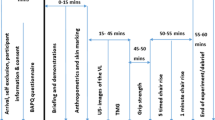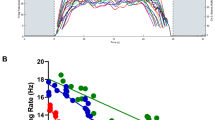Abstract
Age-associated loss of muscle strength is attributed to decreasing muscle mass. Both strength and mass are dependent on peripheral innervation. However, the association between nerve function and age-associated strength loss has not been studied directly. The median nerve contribution to grip strength was estimated using nerve conduction velocity (NCV). Grip strength and NCV were measured in 197 male participants of the Baltimore Longitudinal Study of Aging (age 59.0±13.9 years). Multiple regression and path analyses were used separately to examine the association between median NCV and grip strength. Grip strength showed a negative quadratic relationship with increasing age (r2=0.32, p<0.001) with a major change in slope occurring after 64.7 years of age. Median NCV (r2=0.14, p<0.001) declined linearly with age. Median NCV significantly contributed to grip strength (p<0.001) while controlling for forearm muscle mass (forearm circumference), self-reported 24-hour caloric expenditures, and age. The median nerve has an independent contribution to age-associated levels of muscle strength. The level of the effect was smaller than what could be attributed to forearm muscle mass or age.
Similar content being viewed by others
References
Asmussen E., Heeboll-Nielsen K.: Isometric muscle strength in relation to age in men and women. Ergonomics 5: 167–169, 1962.
Clement F.J.: Longitudinal and cross-sectional assessments of age changes in physical strength as related to sex, social class, and mental ability. J. Gerontol. 29: 423–429, 1974.
Kallman E.A., Plato C.C., Tobin J.D.: The role of muscle loss in the age-related decline of grip strength: cross-sectional and longitudinal perspectives. J. Gerontol. Med. Sci. 45: M82–M88, 1990.
Borges O.: Isometric and isokinetic knee extension and flexion torque in men and women aged 20–70. Scand. J. Rehabil. Med. 21: 45–53, 1989.
Vandervoort A.A., McComas A.J.: Contractile changes in opposing muscles of the human ankle joint with aging. J. Appl. Physiol. 61: 361–367, 1986.
Mathiowetz V., Kashman N., Volland G., Weber K., Dowe M., Rogers S.: Grip and pinch strength: normative data for adults. Arch. Phys. Med. Rehabil. 66: 69–74, 1985.
Brown M., Sinacore D.R., Host H.H.: The relationship of strength to function in the older adult. J. Gerontol. 50A (Special Issue): 55–59, 1995.
Bassey E.J., Bendall M.J., Pearson M.: Muscle strength in the triceps surae and objectively measured customary walking activity in men and women over 65 years of age. Clin. Sci. 74: 85–89, 1988.
Harris T.: Muscle mass and strength: relation to function in population studies. J. Nutr. 127: 1004S–1006S, 1997.
Pendergast D.R., Fisher N.M., Calkins E.: Cardiovascular, neuromuscular, and metabolic alterations with age leading to frailty. J. Gerontol. 48 (Special Issue): 61–67, 1993.
Norris A.H., Shock N.W., Wagman I.H.: Age changes in the maximum conduction velocity of motor fibers of human ulnar nerves. J. Appl. Physiol. 5: 589–593, 1953.
LaFratta C.W., Canestrari R.E.: A comparison of sensory and motor nerve conduction velocities as related to age. Arch. Phys. Med. Rehabil. 47: 286–290, 1966.
Wagman I.H., Lesse H.: Maximum conduction velocities of motor fibers of ulnar nerve in human subjects of various ages and size. J. Neurophysiol. 15: 235–242, 1952.
Mayer R.F.: Nerve conduction studies in man. Neurology 13: 1021–1030, 1963.
Howard J.E., McGill K.C., Dorfman L.J.: Age effects on properties of motor unit action potentials: ADEMG analysis. Ann. Neurol. 24: 207–213, 1988.
Campbell M.J., McComas A.J., Petito F.: Physiological changes in ageing muscles. J. Neurol. Neurosurg. Psychiatry 35: 845–852, 1972.
Henneman E.: Relation between size of neurons and their susceptibility to discharge. Science 126:1345–1346, 1957.
McPhedran A.M., Wuerker R.B., Henneman E.: Properties of motor units in a homogeneous red muscle (soleus) of the cat. J. Neurophysiol. 28: 71–84, 1965.
Tomlinson B.E., Irving D.: The numbers of limb motor neurons in the human lumbrosacral cord throughout life. J. Neurol. Sci. 34: 213–219, 1977.
Doherty T.J., Brown W.F.: The estimated numbers and relative sizes of thenar motor units as selected by multiple point stimulation in young and older adults. Muscle Nerve 16: 355–366, 1993.
Doherty T.J., Vandervoort A.A., Taylor A.W., Brown W.F.: Effects of motor unit losses on strength in older men and women. J. Appl. Physiol. 74: 868–874, 1993.
Doherty T.J., Brown W.F.: Age-related changes in the twitch contractile properties of human thenar motor units. J. Appl. Physiol. 82: 93–101, 1997.
Thomas C.K., Johansson R.S., Westing G., Bigland-Ritchie B.: Twitch properties of human thenar motor units measured in response to intraneural motoraxon stimulation. J. Neu-rophysiol. 64: 1339–1346, 1990.
Kandel E.R., Schwartz J.H.: Principles of neural science, ed. 2. Elsevier, New York, 1985.
Medical Research Council: Aids to the investigation of peripheral nerve injuries. War Memorandum No. 7 (revised ed. 2, 1943). London, Her Majesty’s Stationary Office, 1943.
Shock N.W., Gruelich R.C., Andres R.A., Arenberg D., Costa P.T.Jr., Lakatta E.G., Tobin J.D.: Normal human aging. The Baltimore Longitudinal Study of Aging. Washington, DC, U.S. Government Printing Office, 1984.
Martin A.D., Spenst L.F., Drinkwater D.T., Clarys J.P.: Anthropometric estimation of muscle mass in men. Med. Sci. Sports Exerc. 22: 729–733, 1990.
Heymsfield S.B., McManus C., Smith J., Stevens V., Nixon D.W.: Anthropometric measurement of muscle mass: revised equations for calculation bone-free muscle area. Am. J. Clin. Nutr. 36: 680–690, 1982.
McGandy R.B., Barrows C.H.Jr., Spanias A., Meredith A., Stone J.L., Norris A.H.: Nutrient intakes and energy expenditure in men of different ages. J. Gerontol. 21: 581–587, 1966.
Tabachnick B.G., Fidell L.S.: Using multivariate statistics. Harper & Row, New York, 1983, pp. 107–109.
Loehlin J.C.: Latent Variable Models — an Introduction to Factor, Path, and Structural Analysis. Lawrence Erlbaum Associates, Hillsdale, New Jersey, 1987.
Arbuckle J.A.: Amos Users’ Guide Version 3.6. SmallWaters, Chicago, 1996.
DeJesus P.V.Jr., Hausmanowa-Petrusewicz I., Barchi R.L.: The effect of cold on nerve conduction of human slow and fast nerve fibers. Neurology 23: 1182–1189, 1973.
Denys E.H.: AAEM minimonograph #14: the influence of temperature in clinical neurophysiology. Muscle Nerve 14: 795–811, 1991.
Nielsen V.K.: Sensory and motor nerve conduction in the median nerve in normal subjects. Acta Med. Scand. 194: 435–443, 1973.
Corpas E., Harman S.M., Blackman M.R.: Human growth hormone and human aging. Endocr. Rev. 14: 20–39, 1993.
Fiatarone M.A., Marks E.C., Ryan N.D., Meredith C.N., Lipsitz L.A., Evans W.J.: High-intensity strength training in nonagenarians: effects on skeletal muscle. JAMA 263: 3029–3034, 1990.
Heymsfield S.B., McManus C., Smith J.: Anthropometric measurement of muscle mass: revised equations for calculating bone-free arm muscle area. Am. J. Clin. Nutr. 36: 680–690, 1982.
Taylor P.K.: Non-linear effects of age on nerve conduction in adults. J. Neurol. Sci. 66: 223–234, 1984.
Dorfman L.J., Bosley T.M.: Age-related changes in peripheral and central nerve conduction in man. Neurology 29: 38–44, 1979.
Author information
Authors and Affiliations
Rights and permissions
About this article
Cite this article
Metter, E.J., Conwit, R., Metter, B. et al. The relationship of peripheral motor nerve conduction velocity to age-associated loss of grip strength. Aging Clin Exp Res 10, 471–478 (1998). https://doi.org/10.1007/BF03340161
Received:
Accepted:
Published:
Issue Date:
DOI: https://doi.org/10.1007/BF03340161




